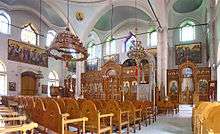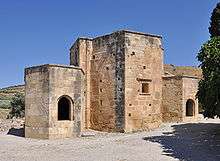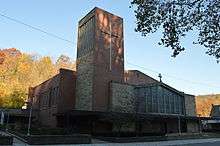Saint Titus
| Titus | |
|---|---|
.jpg) | |
| Bishop and Martyr | |
| Born | 1st century AD |
| Died |
96 or 107 AD Gortyn, Crete |
| Venerated in |
Roman Catholic Church Eastern Orthodox Church Eastern Catholic Churches Lutheranism Anglican Communion |
| Canonized | Pre-Congregation |
| Major shrine | Heraklion, Crete |
| Feast |
August 25 (Eastern Orthodox Liturgical Calendar) January 26 (General Roman Calendar) |
| Patronage | Crete |


Titus (/ˈtaɪtəs/; Greek: Τίτος) was an early Christian missionary and Church leader, a companion and disciple of Paul the Apostle, mentioned in several of the Pauline epistles including the Epistle to Titus. He is believed to be a Gentile converted to Christianity by Paul and, according to tradition, he was consecrated as Bishop of the Island of Crete. Titus brought a fundraising letter from Paul to Corinth, to collect for the poor in Jerusalem. Later, on Crete, Titus appointed presbyters (elders) in every city and remained there into his old age, dying in the city of Candia (modern Heraklion).[1]
Life
Titus was a Greek, apparently from Antioch,[2] who is said to have studied Greek philosophy and poetry in his early years.[3] He seems to have been converted by Paul, whereupon he served as Paul's secretary and interpreter. In the year 49, Titus accompanied Paul to the council held at Jerusalem, on the subject of the Mosaic rites. Although the apostle had consented to the circumcision of Timothy, in order to render his ministry acceptable among the Jews, he would not allow the same in regard to Titus, so as not to seem in agreement with those who would require it for Gentile converts.[4]
Towards the close of the year 56, Paul, as he himself departed from Asia, sent Titus from Ephesus to Corinth, with full commission to remedy the fallout precipitated by Timothy's delivery of 1 Corinthians ([5]) and Paul's "Painful Visit" ([6]), particularly a significant personal offense and challenge to Paul's authority by one unnamed individual ([7]). During this journey, Titus served as the courier for what is commonly known as the "Severe Letter," a Pauline missive that has been lost but is referred to in 2 Corinthians ([8]). After meeting success on this mission, Titus journeyed north and met Paul in Macedonia, where the apostle, overjoyed by Titus' success ([9]), wrote 2 Corinthians. Titus then returned to Corinth with a larger entourage, carrying 2 Corinthians with him. Paul joined Titus in Corinth later. From Corinth, Paul then sent Titus to organize the collections of alms for the Christians at Jerusalem. Titus was therefore a troubleshooter, peacemaker, administrator, and missionary.
Early church tradition holds that Paul, after his release from his first imprisonment in Rome, stopped at the island of Crete to preach. The necessities of other churches requiring his presence elsewhere, he ordained his disciple Titus as bishop of that island,[10] and left him to finish the work he had started. Chrysostom says that this is an indication of the esteem St. Paul held for Titus.[4]
Paul summoned Titus from Crete to join him at Nicopolis in Epirus.[11] Later, Titus traveled to Dalmatia.[12] The New Testament does not record his death.
It has been argued that the name "Titus" in 2 Corinthians and Galatians is nothing more than an informal name used by Timothy, implied already by the fact that even though both are said to be long-term close companions of Paul, they never appear in common scenes.[13] The theory proposes that a number of passages—1 Cor. 4:17, 16.10; 2 Cor. 2:13, 7:6, 13-14, 12:18; and Acts 19.22—all refer to the same journey of a single individual, Titus-Timothy. 2 Timothy seems to dispute this, by claiming that Titus has gone to Dalmatia. (2 Timothy 4:10) The fact that Paul made a point of circumcising Timothy (Acts 16:3) but refused to circumcise Titus (Galatians 2:3) indicates that they are different men.

Veneration
The feast day of Titus was not included in the Tridentine Calendar. When added in 1854, it was assigned to 6 February.[14] In 1969, the Roman Catholic Church assigned the feast to 26 January so as to celebrate the two disciples of Paul, Titus and Timothy, the day after the feast of the Conversion of St. Paul.[15] The Evangelical Lutheran Church in America celebrates these two, together with Silas, on the same date. The Orthodox Church commemorates him on 25 August and on 4 January.
His relics, now consisting of only his skull, are venerated in the Church of St. Titus, Heraklion, Crete to which it was returned in 1966[16] after being removed to Venice during the Turkish occupation.
St. Titus is the patron saint of the United States Army Chaplain Corps. The Corps has established the Order of Titus Award. According to the Department of Defense, the "Order of Titus award is the only award presented by the Chief of Chaplains to recognize outstanding performance of ministry by chaplains and chaplain assistants. The Order of Titus is awarded for meritorious contributions to the unique and highly visible Unit Ministry Team Observer Controller Program. The award recognizes the great importance of realistic, doctrinally guided combat ministry training in ensuring the delivery of prevailing religious support to the American Soldier." [17]
References
- ↑ Smith, William. Smith’s Bible Dictionary 11th printing, November 1975. New Jersey: Fleming H. Revel Company. Pp. 701 – 702.
- ↑ Foley O.F.M., Leonard. Saint of the Day, Lives, Lessons, and Feast, (revised by Pat McCloskey O.F.M.), Franciscan Media
- ↑ "Timothy and Titus", Catholic News Agency, January 26, 2015
- 1 2 Butler, Alban. The Lives of the Saints, Vol.I, (1866)
- ↑ 1 Corinthians 16:10-11
- ↑ 2 Corinthians 2:1
- ↑ 2 Corinthians 2:5-11
- ↑ 2 Corinthians 7:8
- ↑ 2 Corinthians 7:6-15
- ↑ Titus 1:5
- ↑ Titus 3:12
- ↑ Pope Benedict XVI. "Timothy and Titus", L'Osservatore Romano, p.11, December 27, 2006
- ↑ Fellows, Richard G. "Was Titus Timothy?" Journal for the Study of the New Testament 81 (2001):33-58.
- ↑ Calendarium Romanum (Libreria Editrice Vaticana, 1969), p. 86
- ↑ Calendarium Romanum (Libreria Editrice Vaticana, 1969), p. 116
- ↑ The Orthodox Messenger, v. 8(7/8), July/Aug 1997
- ↑ Lake Union Journal. http://www.lakeunionherald.org/103/3/41852.html.
